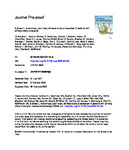A phase II, randomized, open-label, 52-week study of seladelpar in patients with primary biliary cholangitis
| dc.contributor.author | Bowlus, CL | |
| dc.contributor.author | Galambos, MR | |
| dc.contributor.author | Aspinall, RJ | |
| dc.contributor.author | Hirschfield, GM | |
| dc.contributor.author | Jones, DEJ | |
| dc.contributor.author | Dörffel, Y | |
| dc.contributor.author | Gordon, SC | |
| dc.contributor.author | Harrison, SA | |
| dc.contributor.author | Kremer, AE | |
| dc.contributor.author | Mayo, MJ | |
| dc.contributor.author | Thuluvath, PJ | |
| dc.contributor.author | Levy, C | |
| dc.contributor.author | Swain, MG | |
| dc.contributor.author | Neff, GW | |
| dc.contributor.author | Sheridan, David | |
| dc.contributor.author | Stanca, CM | |
| dc.contributor.author | Berg, CP | |
| dc.contributor.author | Goel, A | |
| dc.contributor.author | Shiffman, ML | |
| dc.contributor.author | Vierling, JM | |
| dc.contributor.author | Boudes, P | |
| dc.contributor.author | Steinberg, A | |
| dc.contributor.author | Choi, Y-J | |
| dc.contributor.author | McWherter, CA | |
| dc.date.accessioned | 2022-04-22T11:31:36Z | |
| dc.date.issued | 2022-03-30 | |
| dc.identifier.issn | 0168-8278 | |
| dc.identifier.issn | 1600-0641 | |
| dc.identifier.uri | http://hdl.handle.net/10026.1/19044 | |
| dc.description.abstract |
BACKGROUND & AIMS: We examined the efficacy and safety of seladelpar, a selective peroxisome proliferator-activated receptor-delta agonist, in adults with primary biliary cholangitis (PBC) at risk of disease progression (alkaline phosphatase [ALP] ≥1.67xupper limit of normal [ULN]) who were receiving or intolerant to ursodeoxycholic acid. METHODS: In this 52-week, phase II, dose-ranging, open-label study, patients were randomized (1:1) to seladelpar 5 mg/day (n = 53) or 10 mg/day (n = 55) or assigned to 2 mg/day (n = 11; United Kingdom sites after interim analysis) for 12 weeks. Doses could then be uptitrated to 10 mg/day. The primary efficacy endpoint was ALP change from baseline to Week 8. RESULTS: Mean baseline ALP was 300, 345, and 295 U/L in the 2 mg, 5 mg, and 10 mg cohorts, respectively. Twenty-one percent of patients had cirrhosis, 71% had pruritus. At Week 8, mean ± standard error ALP reductions from baseline were 26 ± 2.8%, 33 ± 2.6%, and 41 ± 1.8% in the 2 mg (n = 11), 5 mg (n = 49), and 10 mg (n = 52) cohorts (all p ≤0.005), respectively. Responses were maintained or improved at Week 52, after dose escalation in 91% and 80% of the 2 mg and 5 mg cohorts, respectively. At Week 52, composite response (ALP <1.67xULN, ≥15% ALP decrease, and normal total bilirubin) rates were 64%, 53%, and 67%, and ALP normalization rates were 9%, 13%, and 33% in the 2 mg, 5 mg, and 10 mg cohorts, respectively. Pruritus visual analog scale score was decreased in the 5 mg and 10 mg cohorts. There were no treatment-related serious adverse events, and 4 patients discontinued due to adverse events. CONCLUSIONS: Seladelpar demonstrated robust, dose-dependent, clinically significant, and durable improvements in biochemical markers of cholestasis and inflammation in patients with PBC at risk of disease progression. Seladelpar appeared safe and well tolerated and was not associated with any increase in pruritus. GOV NUMBER: NCT02955602 CLINICALTRIALSREGISTER. EU NUMBER: 2016-002996-91 LAY SUMMARY: Current treatment options for patients living with primary biliary cholangitis (PBC) are not optimal due to inadequate effectiveness or undesirable side effects. Patients with PBC who took seladelpar, a new treatment being developed for PBC, at increasing doses (2, 5, or 10 mg/day) for 1 year had clinically significant, dose-dependent improvements in key liver tests. Treatment appeared safe and was not associated with any worsening in patient self-reported itch scores. | |
| dc.format.extent | 353-364 | |
| dc.format.medium | Print-Electronic | |
| dc.language | en | |
| dc.language.iso | eng | |
| dc.publisher | Elsevier | |
| dc.subject | Clinical study | |
| dc.subject | Primary biliary cholangitis | |
| dc.subject | Seladelpar | |
| dc.title | A phase II, randomized, open-label, 52-week study of seladelpar in patients with primary biliary cholangitis | |
| dc.type | journal-article | |
| dc.type | Clinical Trial, Phase II | |
| dc.type | Journal Article | |
| dc.type | Randomized Controlled Trial | |
| dc.type | Research Support, Non-U.S. Gov't | |
| plymouth.author-url | https://www.webofscience.com/api/gateway?GWVersion=2&SrcApp=PARTNER_APP&SrcAuth=LinksAMR&KeyUT=WOS:000837192900016&DestLinkType=FullRecord&DestApp=ALL_WOS&UsrCustomerID=11bb513d99f797142bcfeffcc58ea008 | |
| plymouth.issue | 2 | |
| plymouth.volume | 77 | |
| plymouth.publication-status | Published | |
| plymouth.journal | Journal of Hepatology | |
| dc.identifier.doi | 10.1016/j.jhep.2022.02.033 | |
| plymouth.organisational-group | /Plymouth | |
| plymouth.organisational-group | /Plymouth/Faculty of Health | |
| plymouth.organisational-group | /Plymouth/Faculty of Health/Peninsula Medical School | |
| plymouth.organisational-group | /Plymouth/REF 2021 Researchers by UoA | |
| plymouth.organisational-group | /Plymouth/REF 2021 Researchers by UoA/UoA01 Clinical Medicine | |
| plymouth.organisational-group | /Plymouth/Users by role | |
| plymouth.organisational-group | /Plymouth/Users by role/Academics | |
| dc.publisher.place | Netherlands | |
| dcterms.dateAccepted | 2022-02-28 | |
| dc.rights.embargodate | 2022-4-23 | |
| dc.identifier.eissn | 1600-0641 | |
| dc.rights.embargoperiod | Not known | |
| rioxxterms.versionofrecord | 10.1016/j.jhep.2022.02.033 | |
| rioxxterms.licenseref.uri | http://www.rioxx.net/licenses/all-rights-reserved | |
| rioxxterms.licenseref.startdate | 2022-03-30 | |
| rioxxterms.type | Journal Article/Review |


